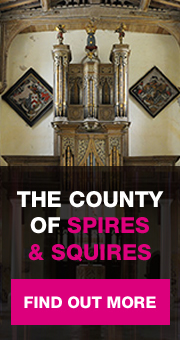A large 14th /15th century church with a slightly earlier tower impressively placed at the edge of the village near the former Norton Hall, formerly a seat of the Knightley family of Fawsley and in the 19th century Beriah Botfield, the bibliophile.
The nave heightened circa 1700. Restoration was carried out here by R. Armstrong 1894. A large reredos now forms part of a huge west screen at the base of the tower.
This large church is full of monuments to the families who owned Norton Hall (blown up in 1945): the Knightleys, (also of Fawsley), the Bretons, and the Botfields.
Apart from the brass to William Knyght (d. 1501) and his wife, the earliest monument is the spectacularly large wall tomb on the south wall of the nave. This is to Lady Elizabeth Seymour (1552-1602), daughter of Edward Seymour, Duke of Somerset “The Lord Protector”, first cousin to Edward VI and second wife of Sir Richard Knightley.
In its splendour as well as in its design it owes much to the tomb of the sitter’s mother, the Duchess of Somerset who died in 1587. Her tomb is in Westminster Abbey and again is executed in painted alabaster richly enhanced with ornament.
The Duke had no such flamboyant memorial. He was simply buried in the chapel of St. Peter ad Vincula having been executed at the Tower in 1549. Lady Elizabeth lies under a rich canopy, her hands clasped in prayer. Note her red cloak lined with fur and the gold tasselled and embroidered head pillow.
The tomb retains a great deal of its original paint and gilding and is a fulsome example of the late Elizabethan love of squiggly ornament, coffering, heraldry, columns, obelisks etc (in its ornateness it may be no coincidence that Geerhaerdt’s portrait of Lady Elizabeth shows her covered in costly jewellery).
After the death of her husband, Sir Richard, the estate was sold to Nicholas Breton whose monument only put up 20 years later, is a very different affair. It is sober and classical. A broken pediment contains his arms beneath which is a centrally placed tablet of black marble flanked by two semi-naked cherubs standing on brackets.
The colouring is also more sober but there is a pleasant controlled use of different coloured marbles and paint is employed to highlight the cherubs’ few draperies. Nearby is another monument to Anne Breton (d.1635); much more Jacobean in quality and mood with a pair of banded obelisks and a skull in the pediment.
Continuing with the Breton family the tomb commemorating the next generation is a very substantial work. Nicholas Breton and his wife appear here as a pair of busts in the centre of a large pink and white marble “altar piece” with free standing black marble columns to either side. The busts stand on elaborate socles of Italianate form. Above their coat of arms hovers between another broken pediment from which emanate large bold garlands of fruit.
Slightly earlier in date is the memorial on the north side of the church to Elizabeth Verney (d. 1633). Again a classical concern with a familiar broken pediment and armorial tablet and beneath the deceased kneeling in prayer.
Above a painted figure holds up her shield whilst either side allegorical figures tell of the shortness of life’s span.
From the Bretons you need to jump to the Botfields: from the 17th to the early 19th century. Thomas Botfield was an ironmaster from Dawley in Shropshire, who acquired the Norton estate circa 1800. Also on the north wall is the tomb to Thomas’ daughter-in-law, Charlotte Botfield (d. 1825). It is almost shockingly austere. It shows her son mourning at her tomb sculpted in high relief. This tomb deserves to be much better known as it is undoubtedly one of the finest neo-classical monuments in the county. It is a relatively early work by William Behnes (1795-1864) when to some extent he was at the height of his powers.
Behnes was the son of a piano maker from Hanover who first settled in Dublin and then in London. As a young man he attended the Royal Academy Schools and in the early 1820s was also engaged on the statue of George IV for Dublin Castle, the Hon. Charles Lambton (Sir Thomas Lawrence’s Red Boy) for Lambton Castle, and of Alexander Hope for The Deepdene.
His only other work in Northamptonshire seems to be the memorial to Lord James Fitzroy at Grafton Regis.
Before leaving Norton, take a look at the vast decaying family mausoleum in the churchyard, to the south east of the church off what must have been the path to the Hall. This is to the whole Botfield family and is a huge tomb chest with a roof topped by a swagged urn. The whole surrounded by iron railings with flaming tops which was presumably made at the family’s own iron foundry. The tomb, though, is a local affair, being made by Baseley of Daventry.
Please refer to the Glossary for any terms in the text that you are unfamiliar with.







